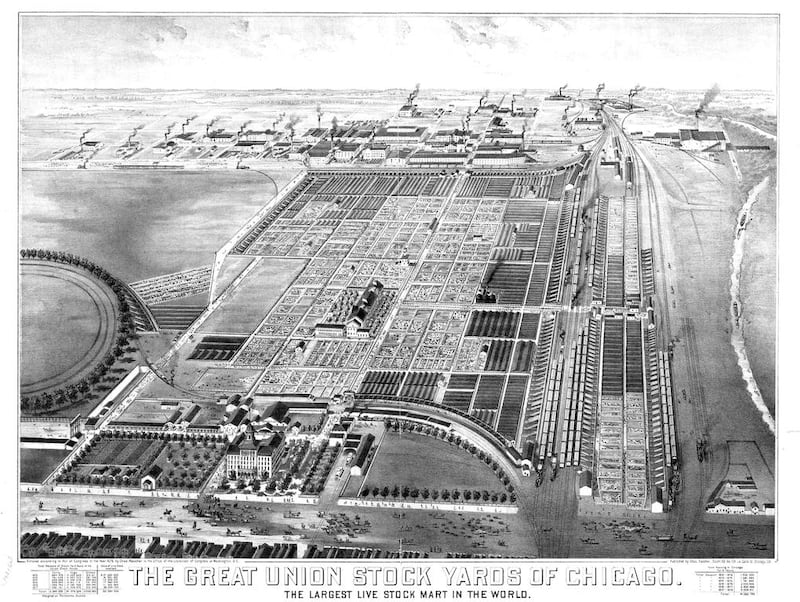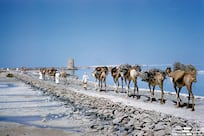Part one: A story of innovation
The story of the phenomenal rise of the Chicago slaughterhouses in the late 19th and the early 20th century is in large part a story of innovation, and as such can offer inspiration for the innovators of today.
In his book Slaughterhouse, published last October, the Columbia College Chicago history professor Dominic Pacyga traces the rise, fall and rebirth of the city's stockyards.
Mr Pacyga has a personal connection with the subject. His grandparents emigrated from Poland to America and found work in the Chicago meatpacking industry. Mr Pacyga, as a young man in 1969, quit a job in a steel fabricating plant and found summer employment at the Union Stock Yard, helping to drive hogs to their fate. That spawned a lifelong fascination with the stockyards and their role in the industrial development of Chicago and indeed America.
Here, he describes how the Chicago meatpacking district attained its glory days and helped to help drag the world into modern industrial culture through innovation - innovation in transportation processes, in manufacturing processes, and in organisational processes (the latter even providing a template to Henry Ford).
Our excerpt begins below.
Transportation
In order for Chicago packers to extend their reach into the nation’s beef market, they had to find a way to ship fresh meat east. Chilling beef in Chicago was easy; but keeping that meat fresh until it could reach eastern markets was another thing. Refrigerated railcars were the answer. Detroit meatpacker George H. Hammond Company shipped the first chilled meat in an ice-packed boxcar to Boston in 1868. William Davis had designed Hammond’s refrigerated car the year before as a simple device, basically a boxcar insulated and packed with ice. While the meat arrived in edible condition, the cars had to be filled with new ice daily, and the meat became discolored by contact with it.
Despite Hammond’s initial success, meatpackers still lacked the ability to transport commercially viable beef over long distances. Hammond’s limited achievement, nevertheless, induced him to move his plant from Detroit to the Chicago area next to an ice-harvesting plant. His operation in Hammond, Indiana, began to introduce the nation to chilled beef. Chicago packers knew refrigerated railcars could be a major breakthrough that might give them control over the national market.
In 1877, two years after arriving in Chicago, August Swift suffered losses shipping cattle east to New England butcher shops. In response, he attempted an experiment, sending two carloads of dressed beef east during the winter. Swift shipped the meat in stripped down express railroad cars with their doors left open to keep cold air moving across the beef. The success of the venture convinced Swift to continue his experiments. The next year, Swift hired engineer Andrew Chase to design a refrigerated car. Chase came up with a simple solution of placing boxes filled with ice and brine at both ends of the car, venting them so that chilled air passed throughout the car. Soon all major firms in the dressed beef trade started using refrigerated railcars.
Maintenance of the ice cars necessitated an entire new infrastructure, and the demand for ice soared. By the 1880s, Swift and Company alone consumed 450,000 tons of ice. Eventually, Chicago firms reached all the way north to Green Bay, Wisconsin, for ice. Swift established a series of icing stations to refill the railcars as they made their way to the East Coast. Each car required an average of one thousand pounds of ice per station on a typical four-day trip. At first, the railroads balked at carrying the new refrigerated cars since they made greater profits moving live animals, but Swift and Armour arranged for the Canadian Grand Trunk Railway, a railroad that had done little business in the livestock trade, to carry the cars. By 1885, the Grand Trunk hauled 292 million pounds of beef east annually. Despite a hard fought battle by local packers and butchers against “embalmed” beef, Chicago packers won the minds, taste buds, and dollars of East Coast consumers.
Manufacturing
Chicago’s meatpackers embraced new technology as the market grew.
For example, the invention of a tin can making machine in 1847, and Gail Borden’s success with condensed milk, popularized the idea of buying food in tin containers. Preserved meat, however, did not come out well in the cans: the canning process created an unappetizing mixture of water, grease, and tired looking meat. A process devised by William J. Wilson, and the introduction of steam pressure autoclaves in the winter of 1873–74, solved that problem, and Wilson soon had a thriving business based in Chicago. A small packer founded in 1868, Libby, McNeil and Libby, secured Wilson’s permission to use his pyramidal can and started producing corned and roast beef in cans. By the 1880s, sales soared, and Libby, McNeil and Libby had a huge modern plant and canned two hundred thousand cattle a year. Other packers quickly joined the canned beef trade.
Advances in the development of by-products also transformed the industry. Before the Civil War, packers simply discarded most of what they considered waste. They dumped grease and blood as well as offal in the Chicago River or in nearby fields, causing noxious smells and health problems. Increasingly, these by-products came to be seen as moneymaking parts of the industry, providing the larger meatpackers with yet another economic scale advantage. The often-told story of August Swift walking along Bubbly Creek to see how much waste flowed from his plant into the Chicago River’s West Fork may be a myth, but like all myths, it shows something important. Supposedly, Swift rushed back to the slaughterhouse to discover the source of the waste and made sure that his employees stopped the practice and used grease and offal for profit.
Generally speaking, by-products consisted of a wide variety of goods ranging from hides to horns to the pineal glands taken from the brains of a steer; they comprised basically anything produced on the killing floor other than dressed meat. Chicago’s major packers differed as to what by-products they produced.
By-products from cattle included hides, glue from sinews, blood meal lubricating oil, soap, inedible tallow, inedible gelatin, candles, stearin, sausage casings, pituitary tablets, calf drumheads, buttons, neat’s-foot oil, bonemeal, granulated bone, combs, pipes, and hair clips, among others.
Hogs produced glue, oil, bone lime, benzoinated lard, hair for mattresses, gloves, pig’s foot oil, sausage casings, and a host of other products. Hog stomachs provided pepsin, while the pancreas or hog sweetbreads provided a source for insulin. Hog hairs filled the cushions of sofas, davenports, mattresses, and automobile seats as well as providing insulation. They really did use every part of the hog but the squeal.
Organisation
Chicago’s packinghouses innovated not only in the creation of products, but also in the configuration of their business. They participated in an organizational revolution that transformed American capitalism in the late 19th century and brought the modern to the entire business process. These huge profit-making industrial companies could not be run in the same manner as the small packing companies of the Civil War era. Armour, Swift, and Morris needed more control, more information to process in order to maintain and expand profits. They required a new effective organizational structure. Modern capitalism of course emerged in various industries, but the alteration of the age-old business of butchering provided one of the most innovative stages for management to develop.
A growing class of white-collar management workers emerged to run the multifaceted business.
Since chilled beef had to be consumed within three to four weeks after slaughter, it led to an immense investment in capital equipment and to the creation of a bureaucracy to manage the business, now national in scope.
The great packers kept large clerical staffs in their Chicago offices: Swift and Armour each employed about one thousand male and female clerks. From at least the mid-1890s on, these companies created a modern, complex, sophisticated hierarchy to operate their vast enterprises. The creation of a bureaucracy and the delegation of authority to qualified and goal-oriented employees was certainly part of the modern. In turn, it affected the entire business model. The high volume generated by their national sales and distribution networks led to the specialized subdivision of labor in the process of slaughtering and dressing livestock, but only after a carefully designed administrative arrangement permitted the movement of large numbers of animals through the packing plants. A network of livestock buyers plied not only the Chicago Stockyards, but also rival stockyards and the countryside in order to fuel the great packing machine. The packers maintained a purchasing division that bought the large amount of supplies necessary to maintain the trade. From clerks to buyers, and salesmen, this was a modern business.
Armour and Company divided its sales organization into two large subunits and a small one. The large units dealt in beef and hog products. The smaller unit dealt in laboratory by-products. All three marketed products in 1900 through Armour’s 200 nationwide branch houses. Armour and Swift organized their carlines and branch houses to report to 25 district superintendents. The branch houses took orders, arranged for local advertising, handled billing and the transfer of funds back to Chicago. Swift had 193 such branch houses in 1900, while Morris maintained 77, and S&S had 44.
The Chicago headquarters then assigned a packing plant to supply each of the branch and car lines. If the supplying plant fell short because of a lack of livestock, a strike, or some other problem, Chicago supplied the car lines and branch houses from another plant. They handled surpluses in the same centralized way. In this manner, the Chicago offices could control the entire market for their products and make logical— and profitable— choices as to supply and demand. The head offices maintained constant telegraphic communication with their agents, and as early as 1889 Armour had established a division of its accounting department devoted exclusively to the branch houses.
The massive organizational model that developed as a consequence of these changes in the meat industry not only altered it, but also provided a model for other manufacturers. The story told of Henry Ford getting the idea for his automobile assembly lines from the packers is just one example of the impact these “new” businesses had on industrial development. The packers became what is now called “vertically integrated,” at least exercising some control over the livestock markets, the advertising and supply chains, as well as distribution. They attempted to control the entire industry from the farmyard to the dinner table, creating a vast meat monopoly.
------
Part two: A sense of spectacle
It is hard to imagine a slaughterhouse as a tourist attraction, but so novel and modern was Chicago’s industrial approach to butchery that masses of families thronged the Union Stock Yard to witness its “disassembly line” and its rivers of blood. In this passage, Mr Pacyga describes the odd allure of the place. Its backers took a full-throated approach to marketing that one can see echoed today in the efforts of cities from New York to Dubai and Barcelona to Sydney.
The excerpt
High above Packingtown, on the very roofs of the slaughterhouses, visitors gathered to witness the modern in all of its terrible efficiency. Thousands of hogs waited in pens. Livestock handlers drove roughly a dozen hogs at a time onto the kill floor as fascinated spectators watched the beginning of a process that helped redefine American industry and changed interactions between animals and human beings, as well as workers and management. Swift’s massive plant killed thousands of hogs a day. Here animals met their fate at the hands of workers and machinery, creating a vast “disassembly” line that ended not just the lives of pigs but the age-old relationship between meat and mankind.
The “river of blood” that flowed just below the roof pen area attracted Chicagoans and tourist alike for most of the stockyard’s existence. At the turn of the twentieth century, a reported five hundred thousand people visited the Union Stock Yard annually. To modern sensibilities to take a tour of the stockyard and the packing plants — even to bring small children to the hog kill— might seem repulsive, but through most of its history the Union Stock Yard and the adjacent plants were major tourist attractions. Fascination with the new drew these visitors. Here people faced the modern head on with all its innovation and spectacle. For many people, Chicago’s vast livestock market and packinghouses presented a compelling if somewhat frightening window to the future.
The livestock market opened on Christmas Day 1865. As a tourist attraction, the stockyard defined Chicago to a fascinated public in the post– Civil War era.
Visitors to the Union Stock Yard entered through the Stone Gate on Exchange Avenue, the main thoroughfare of the stockyard. As they proceeded west toward the Exchange Building, they passed the guardhouse and the cattle market.
The tour of the Swift plant began at the “Visitor’s Entrance,” which included showcases of the company’s finished products such as sausages, hams, and soap. Elevators then took the guests up to the roof of the pork house. Workers herded hogs, after being driven in some cases more than a mile, into holding pens on the roofs of the plants, where they rested overnight. Later this changed as it was felt that a much briefer cooling-off period was sufficient. Most packers felt that overheated hogs, or hogs overexcited after having been driven some distance, had to be allowed to “cool off” or to become perfectly quiet to prevent the meat from becoming “feverish.” Swift and Company had a yard capacity of 5,000 hogs.
After the animals’ night of rest, laborers washed them down and drove a dozen or so at a time into a pen where a worker, often a young boy, shackled their rear leg to the Hurford Wheel— a hoisting machine that raised the hog steadily until the shackle hook dropped unto a sliding rail. The animal would give out a loud shriek as the device suddenly pulled it into the air, on its way to the sticker, or dispatcher, who slit its throat. A cascade of blood gushed from the open wound. The sticker, covered in blood and standing in a pool of the hog’s gore, stopped for a few seconds to let the blood drain. Every ten seconds another hog appeared before the skilled slayer. To many visitors, the sticker seemed a most repellent sight. He represented the most gruesome spectacle, one that remained with the tourist long after he or she left the stockyards.
The sticker, who was working rather than sightseeing, then pushed the hog carcass along the rail to the boiling vats. Men stood alongside the vat with poles to keep the hog rolling in the water until it reached the end of the vat, where an apparatus captured the carcass and dropped it on a table so that other laborers could take the hair from its ears, which was used for artists’ paintbrushes and other such products. A machine then lifted the hog onto a scraper machine that removed most of its bristles.
The hog then moved to the hog-dressing department, where men opened the bodies and removed all internal organs. Some men detached the fat for the production of lard. Two men wielding cleavers cut each hog carcass into two halves, which then passed to the hog-drying room. It took the hog 20 minutes to move from the shackler to the hog-drying room. In about two hours, the carcass dried enough to be placed in coolers.
Visitors then moved to the first pork cutting station, where they observed hogs that had been in coolers kept at 32 degrees Fahrenheit for forty-eight hours. They saw the carcass subdivided into the various cuts — hams, shoulders, and sides — as demanded by the various markets across the country and overseas. Each pork cutter had his particular cut to make with a heavy cleaver. The men worked so quickly and accurately that the pork seemed to melt and vanish as it moved from block to block. As the guests progressed to the next pork cutting room, the cuts from the room above moved down chutes to be further trimmed, the pork loins removed, and those pieces to be cured and smoked prepared for those departments.
Picture postcards
Those who could not visit the Chicago Union Stock Yard or Packingtown in person could purchase the various illustrated guides or use a stereopticon or stereoscope to explore the area. These were a popular form of entertainment, allowing people to see the world from their living rooms. Photographers took a picture with a special camera that had two lenses and printed the photographs side by side. When viewed through a special device, the pictures blended into a three-dimensional image. By the end of the 19th century, many middle- and upper-class people owned these devices. They were praised for their accurate depictions of the world, bringing to the average person sights often unobtainable without a good deal of expense and travel.
Stereopticon photographs of the Chicago Stockyards and Packingtown covered just about every phase of the process, and they provide a fascinating historical record of methods and conditions in the Chicago packinghouses. At times, the stereopticon cards contained a written explanation of the scene depicted on the back. Others simply left the explanation to the photograph. In either case, images of the pens, chutes, and packing plants found a ready audience in the stereopticon trade. These images were not only sold in the United States; Europeans and others could view the sights of Chicago’s meat industry no matter how far they lived from South Halsted Street.
Postcards too brought the scenes of the Chicago Stockyards to individuals around the world. Their images, like the stereopticons, depicted not only the market, but also the packinghouses. Views of cattle in the pens seemed to be among the most popular, but others showed the Transit House hotel, the horse market, and the various draft horse teams owned by the packers and the USY&T Company, as well as the Exchange Building and the various packinghouse general offices. Still others featured the packing process, including the Hurford Wheel, the sheep kill, the cattle knocking pens, coolers, beef dressing and cutting departments, and aerial views of the packinghouses. The French journalist Jules Huret explained that the packers realized the value of publicity and never failed to take advantage of it. The stereopticons and color postcards allowed them to amaze a large public with the size and complexity of the industry, and to convince the skeptical potential customer of the cleanliness of their methods.
Some packers even produced the meat industry equivalent of baseball cards. Libby, McNeil and Libby issued colorful trading cards depicting the images of literary characters such as Shakespeare’s Falstaff enjoying canned Libby, McNeil and Libby meat. Others extolled their cooked corned beef as valuable for explorers and travelers by portraying a frontiersman walking into the wilderness with his gun, his dog, and a huge can of corned beef under his arm.
-----
Part three: The inevitable decline
In this selection, Mr Pacyga asserts that the decline of the Union Stock Yard and the surrounding Packingtown district was a result of changes in transportation, manufacturing, and in the raising and purchasing of livestock.
The excerpt
During World War One, nearly fifty thousand people worked in the Union Stock Yard and Packingtown, and a quarter of million depended on the industry for their livelihood.
In the 1920s, the major packers began to decentralize in earnest and to mimic smaller independent midwestern packers and purchase livestock directly from producers, by-passing the Union Stock Yard. In the 1950s, Chicago’s central location and railroad access no longer mattered to the major slaughterhouses that had long called the city home. Direct buying, the interstate highway system, and the refrigerated motor truck gave the packers more leeway to choose profitable locations. Changes in the way livestock were raised also encouraged the makeover. Eventually with that transformation came a tremendous readjustment in the industrial hierarchy that witnessed the decline of Armour, Swift, Wilson, and the emergence of other packers who came to dominate the industry. By 1960, Chicago’s major packing plants had closed, and only small independent packers operated in the area. When the Union Stock Yard celebrated its one hundredth anniversary in 1965–66, it had returned largely to its original role as a shippers’ market.
Beginning of the end
As World War One came to an end, it seemed as if Chicago would never relinquish its hold on the industry and the nation’s meat supply. Organized labor lay defeated by strong opposition from the packers, its own internal conflicts, and lack of government support. In its place, a type of corporate welfare was established with the hope of keeping unions out permanently, what one author called the “Humanizing of the Packing Industry.” During this time, the packers established better working conditions, medical services, some pensions, lunchrooms, and other improvements— all in the name of industrial peace and, of course, corporate profits. The Square Mile continued to generate millions of dollars for investors and to lead the industry’s foray into the modern.
Despite Chicago’s continued dominance, a significant transformation began in the early 1920s. As a result of the increase in the slaughtering of cattle in packinghouses in Iowa and Wisconsin, cattle receipts from 1923 to 1929 posted an 18 percent decline. This indicated the predicted trend of farmers selling at a market close to them, and the increased use of trucks. While livestock trucks proved convenient to farmers, the relatively high rates charged for trucking cattle favored the marketing of animals in stockyards or as direct sales closer to producers. Truck deliveries of cattle rose for sixteen markets from 2.9 percent in 1923 to 13.47 percent in 1929. This trend would prove important for all of the large terminal markets.
Things were changing, slowly, but surely.
Put simply, the increased use of livestock trucks in turn decreased Chicago’s advantage as a transportation nexus. Trucks were more flexible, and once reliable refrigerated trucks appeared on the nation’s highway system, the railroads that crisscrossed the country and ran through Chicago lost their predominance in the meatpacking industry. Both direct buying of livestock by meatpackers and the use of the truck affected the Union Stock Yard. This would be a trend that increased after the Great Depression and World War Two, but had already made its mark on the industry by 1930.
Once the Great Depression and World War Two ended, management looked— as it always had— toward modernization and new technologies. The increased use of trucks to move livestock and the refrigerated truck to move meat products provided a greater geographical flexibility for the industry. Once again, Chicago’s packers were at the forefront of change as they worked to maintain their market position. In the immediate postwar era decentralization, the truck, single-storey plants, interstate highways, and the suburbs created a new sense of the modern.
In October 1952, Swift and Company closed down its hog slaughtering operations in Chicago claiming that hog receipts were too small and the buildings too expensive to maintain. What the Chicago Tribune called one of the stockyards “best-known spectacles” came to an end. Swift and Company maintained that it intended to continue purchasing hogs on the Chicago market for shipment to its plants in other cities and towns, but nonetheless the Swift decision portended the complete decline of the industry in Chicago.
That same year, Wilson opened a modern packinghouse in Kansas City. The new structure proved to be more efficient than the old, giant, nine-storey packinghouse it replaced. The old Kansas City plant had consisted of several buildings over thirteen acres and occupied more than a million square feet. Wilson replaced it with a two-storey building that covered only one acre. The hog butchering functions, which had processed 150 hogs per hour, had taken up two stories in the older structures; now, the hog kill floor was contained in a single eighty-by-fifty-foot room. The new slaughterhouse took advantage of modern manufacturing techniques, especially an engineered line layout in the pork cutting and trimming department. It proved to be a pacesetting plant for Wilson and Company as well as for the industry, symbolic of the way that earlier innovations had set the pace on the Chicago kill f loors.
Three years later, in 1955, Wilson and Company shuttered its massive slaughtering operations in Chicago. On September 17, Wilson ceased all cattle operations in the city. A week later, the company closed down its hog kill. The shutdown took its toll on some three thousand workers, of which over two thousand were African Americans, and shocked Packingtown employees. The company said that the plant was old, outmoded, and expensive and that it planned to move operations to Cedar Rapids, Iowa, Albert Lea, Minnesota, and Omaha, Nebraska.
On the farm
The raising of livestock had gone through a vast transformation since World War Two. The factory system, which had so transformed the packing industry in the 19th century, now provided a model for livestock producers. As early as the 1920s, farm advocates touted the factory-like farm as a way of ensuring farmers’ profits and maintaining low food prices. Shortages during World War Two, especially of animal feed, had forced farmers to look beyond traditional sources such as corn to feed cattle and hogs. Also the use of antibiotics transformed the industry. The war and its aftermath increased the rural labor shortage and farmers again began to look at technology to replace hired hands. In addition, the growth of chain stores such as A&P, National Tea, and Kroger also influenced the market for meat animals.
One result was the emergence of factory farms that produced great quantities of livestock. These new farms provided a quality product at a reasonable cost to a quickly expanding American consumer society. By 1966, Colorado’s Monfort feedlots resembled a modern high-tech plant. Computers regulated the daily diets of animals, and fewer workers were needed to manage the huge herds. Trucks and a network of paved roads now connected these feedlots with urban centers. Meatpackers no longer had to rely on stockyards and commission men for the bulk of the livestock needed for their plants.
The removal of millions of acres of western range for grazing also affected livestock producers who were now confined to smaller and smaller spaces. Federal land policies therefore also contributed to animal confinement and the use of feedlots. In addition, packers began to open their own feedlots. The quest for efficiency and for cheap meat created a new era for meatpacking, which would eventually see the emergence of new companies such as Iowa Beef Packing that would cater to the convenience store and institutional food market.
Swift, in its attempt to purchase enough hogs for its North Carolina plant, leased sows to farmers who agreed to take at least fifty of them and to guarantee their sale to Swift. As one reporter wrote, “The businessman at one end of the line ships out standardized pigs to farmers who will feed them according to a set pattern.” The result was a revolution in hog raising that swept across the country and hit midwestern farms hard as they began to lose their control over the industry to other parts of the country. In response to these changes, meatpackers left cities and opened plants in rural areas. Efficiency became a key word, and the new plants hardly resembled the old structures that had dominated Chicago’s Packingtown. Now instead of symbolizing modern techniques, Packingtown looked old and backward.
In October 1970, less than five months after the closing of the hog market, the USY&T Company announced that the cattle market would also close on February 1, 1971.
John “Happy” Durant, the general livestock supervisor of the Union Stock Yard, was 57 years old and had worked in the stockyards for 39 years. He remarked, “All the yards are going downhill. The whole trend started in World War II. The government tried to get farmers to ship closer, to save on gas and tires. The packing companies started moving closer to the farmers.”
Wally Manders, the president of the Lincoln Meat Company, exclaimed, “Now what will we do?”
Postscript
As Mr Pacyga writes in the final chapter of Slaughterhouse, the district has been reborn. The site is now home to Stockyard Industrial Park, where green-foods companies thrive alongside a last few remaining slaughterhouses. “The Union Stock Yard,” he writes in concluding his book, “may have been only the beginning.”
Reprinted with permission from Slaughterhouse: Chicago’s Union Stock Yard and the World It Made by Dominic A. Pacyga, published by the University of Chicago Press. © 2015 by The University of Chicago. All rights reserved.
Follow The National's Business section on Twitter





